| Overview |
An Item is an object that contains all information related to a physical object that is being managed and tracked.
In general, any object that has an internal corporate part number that you need to manage revisions and changes for would appear as an Item in the Omnify database.
Examples of what an Item can represent would be:
- Component/part
- Wires, cables, harness
- Sub assembly (BOM) or full assembly (multi-level BOM)
- Document
- Set of documents
- Fasteners, adhesives, kits
- Software/Firmware components
- Etc.
|
|
|
The Item/Part form is used to display data about all items regardless of their type.

The Item Form contains the following main areas:
| Item Banner |
Displays Part Number, Description, Status, Revision List and is visible from all Data Pages |
| Data Page Navigator |
Provides quick links to all available data pages |
| Data Page Pane |
Lists all data for the currently selected data page |
| Rev List |
Lists current and all prior revisions of the item |
|
 |
Item Banner |
Top |
|
The Item Banner displays the following information:

| Copy Icon |
Clicking will copy the item to the system buffer (for subsequent Paste operations) |
| Name, Info, Action Menu |
Displays the current Part Number and Description. Placing mouse over will invoke form Action menu. |
| Status Area |
Indicates internal state of item (Pending, Under ECO, etc>). Status area will be blank for released items. |
| Rev List |
Displays a list of the current and all prior revisions. You can change the revisions you are viewing by selecting it from the list. |
Clicking the top left icon will redirect you to the Desktop Home Page.

Clicking the Copy icon will place the item to the system buffer (for subsequent Paste operations).

Placing mouse over the Part Number/Description will invoke form Action menu.
The menu will contain the following commands:

| Refresh |
Refreshes/Reloads the item |
| Return to Desktop Home |
Redirects you to the Desktop Home Page |
| Search Database |
Redirects you to the Database Search form |
| Logout |
Logs you out of Desktop |
| Copy Item |
Places the item in the system buffer |
| Bookmark Item |
Bookmarks the form |
| Send/Export Form |
Invokes the Send/Export page |
| Create New Like |
Invokes the New Like form |
The top right section of the banner contains the following hyperlinks:

| Refresh |
Refreshes/Reloads the item |
| Home Page |
Redirects you to the Desktop Home Page |
|
 |
Navigator Pane |
Top |
|
The Data Page Navigator allows you to quickly jump to the different sections of data for the item.
Selecting an item from the list will update the data page pane to display that data section.
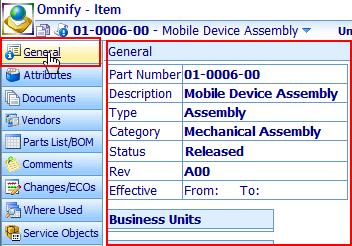
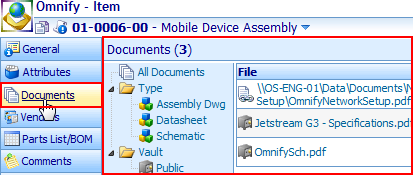
The Navigator page names can be modified using XML Dictionary files.
Contact a qualified Omnify Application Engineer for more information on creating XML Dictionary files.
|
 |
Item Data Pages |
Top |
|
The Data Page Pane displays the item data for the currently selected page and contains a toolbar for quick access to commonly used functions for that page.
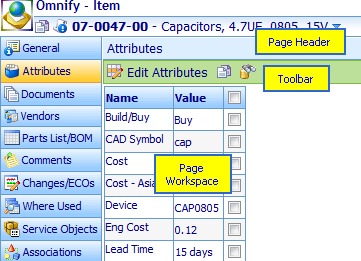
All Items contain the following data pages:
| General |
Part Number, Description, Type, Category, Revision, Status, Projects, Business Units |
| Attributes |
Item Attributes/Parameters |
| Documents |
All associated documents |
| Vendors |
Manufacturer/Supplier/Distributor information (i.e. Vendor name, part number, attributes, vendor documents, etc. |
| Parts List/BOM |
Parts List/BOM information |
| Comments |
User defined notes/comments |
| Changes/ECOs |
Formal Changes (ECOs, ECRs, ECNs) that have been raised against the current item |
| Where Used |
Parts Lists/BOMs that the current item appears on |
| Service Objects |
Service related data such as Serial/Lot Numbers, Customers, etc.). |
| Associations |
Other associated items (not contained on BOM) |
| History |
List of changes that have occurred to the item (User, Date, Tool Used) |
| Signoff |
Users who are reviewing or are required to sign-off on this item |
| Training |
Associated training items |
|
|
|
Each database item can contain an unlimited number of revisions.
Each data set stored with an item is separate for each revision.
You can always return to a prior revision to view/edit the data set at that rev level.
To up-rev any item:
- Change the Rev label on the General Page
- Up-rev the item under Change/ECO (Affected Item page)
The General Information Page contains a Rev Label text box that displays the rev currently being viewed.

Note: Each revision can contain Effective dates.
The Item Banner contains a drop list that displays the current and all prior revisions.

Changing the selection in this list will automatically update the data pages with the data from that revision.
Omnify administrators can enable permissions to modify the revision order and labels as well as revision deletion.
For users with revision editing permissions, an Edit icon will appear next to the Rev list.

Clicking the Revision edit icon will invoke the Revision Labels/Order dialog box.
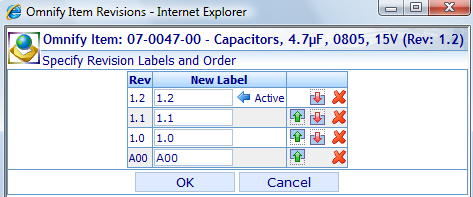
The dialog box will list the current labels and order of all revisions of the item.
To modify a revision label, type the new label in the New Label column.
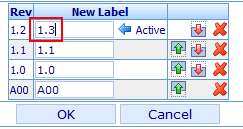
To change the revision order, use the Move Up and Move Down icons.
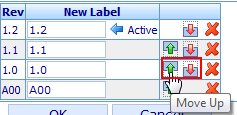
To delete a revision, use the Delete Revision icon.
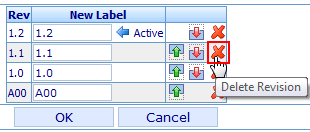
|
 |
Deleting Items |
Top |
|
You can delete database items from the Database Search form.
To delete an item, check the item you wish to delete and then click the Delete toolbar button.

Due to Administrator settings, you may not be able to delete the item and/or revisions if they are in use on BOMs, Changes, Documents, etc.
The system will check the item and display any issues.

|
 |
Exporting/Printing/Sending |
Top |
|
Since Desktop is a web browser based application you can print, send, and export using the built in functionality of the browser.
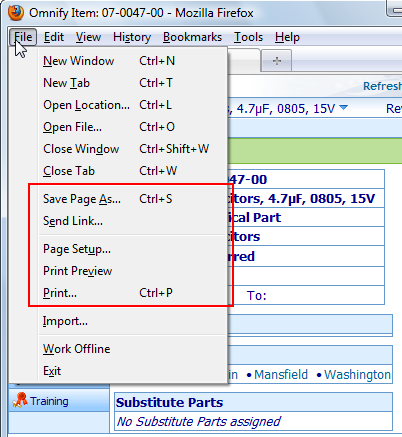
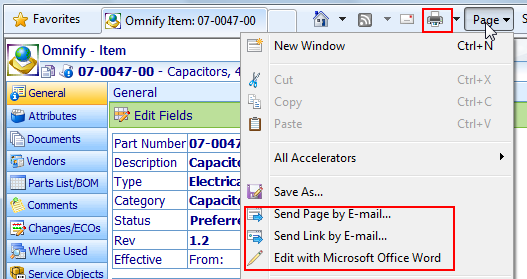
The system will also create a single file that contains the item form data.
To create (and email) the item as a separate file, select the Send/Export Form command from the banner action menu.
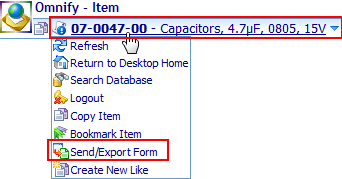
Selecting the command will display the Send/Export page.
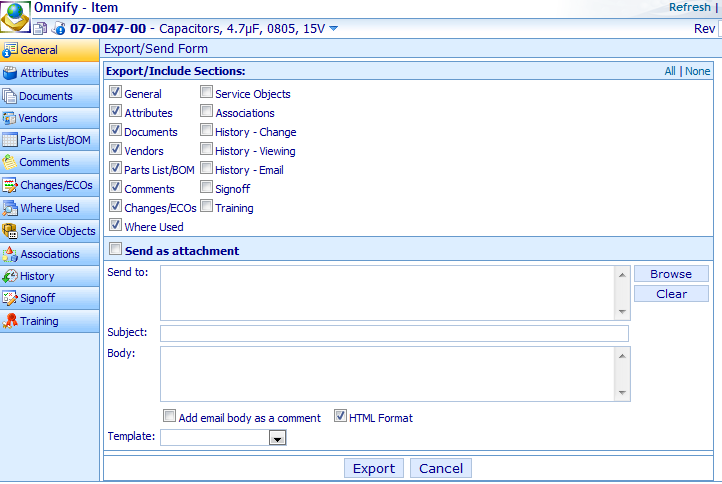
The Send/Export page allows you to select the sections to include.
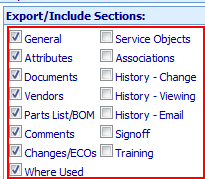
If you wish to email the file, check the Send as attachment checkbox.
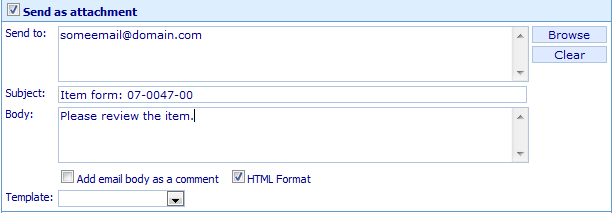
In the Send as attachment area you can type or browse for the email addresses and specify the Subject and Body of the email.
To export and/or send the file, click the Export button.

If you do not send the file, the system will create and download the file.
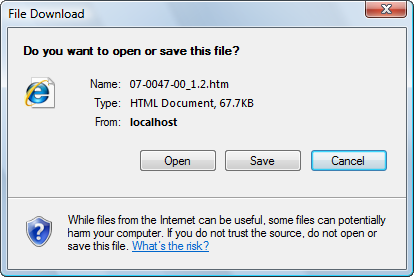
|